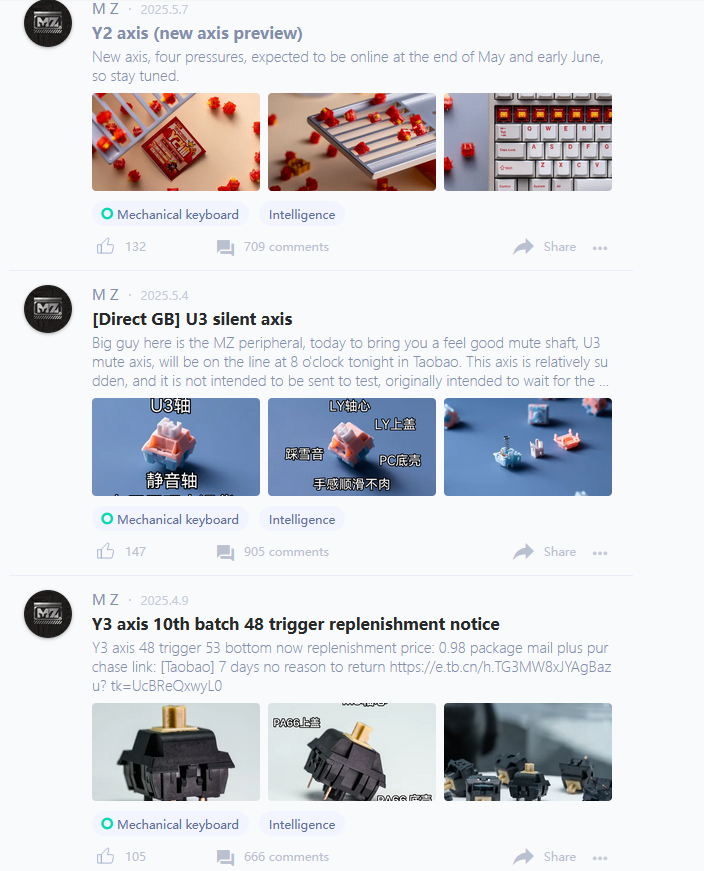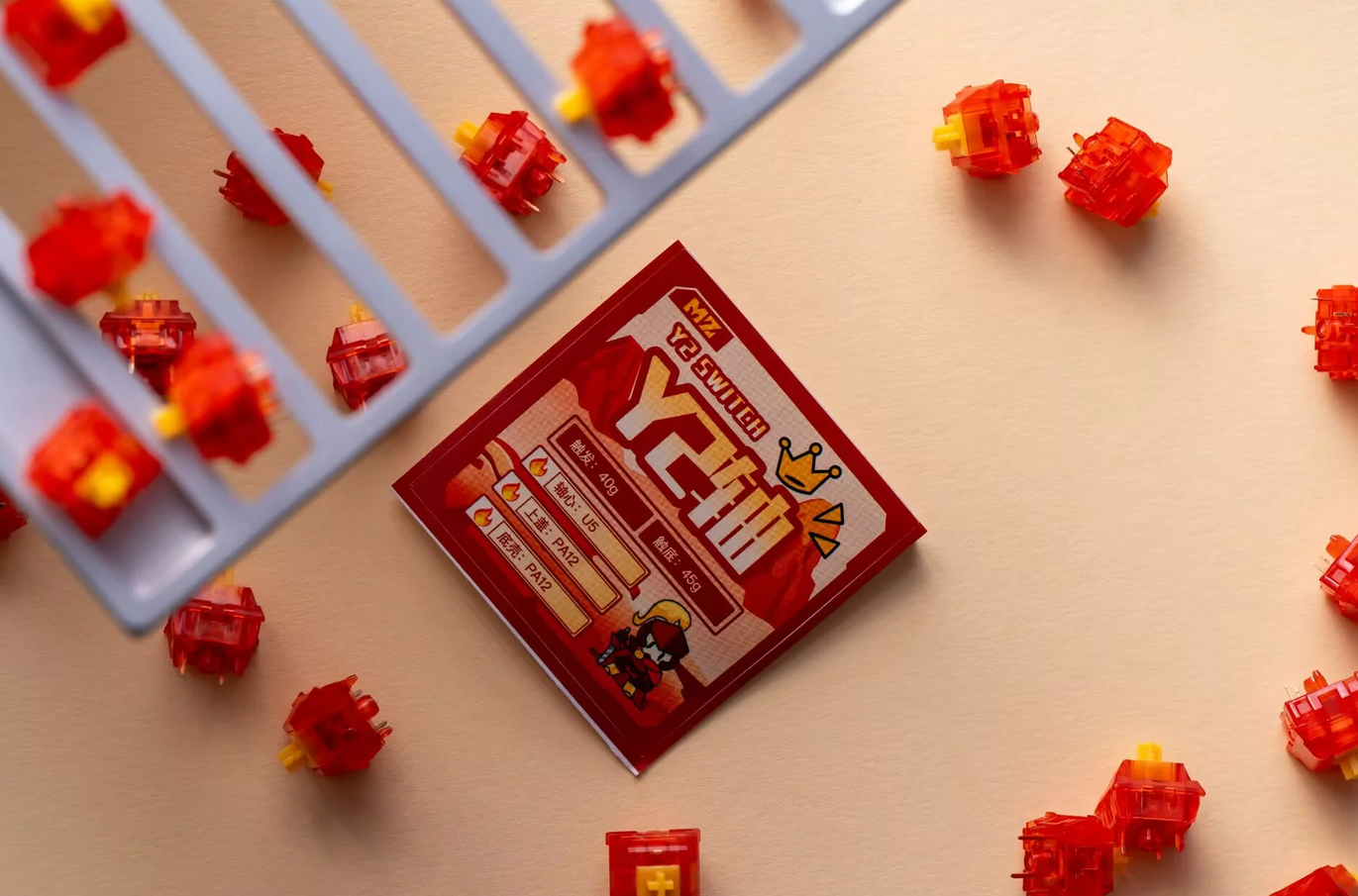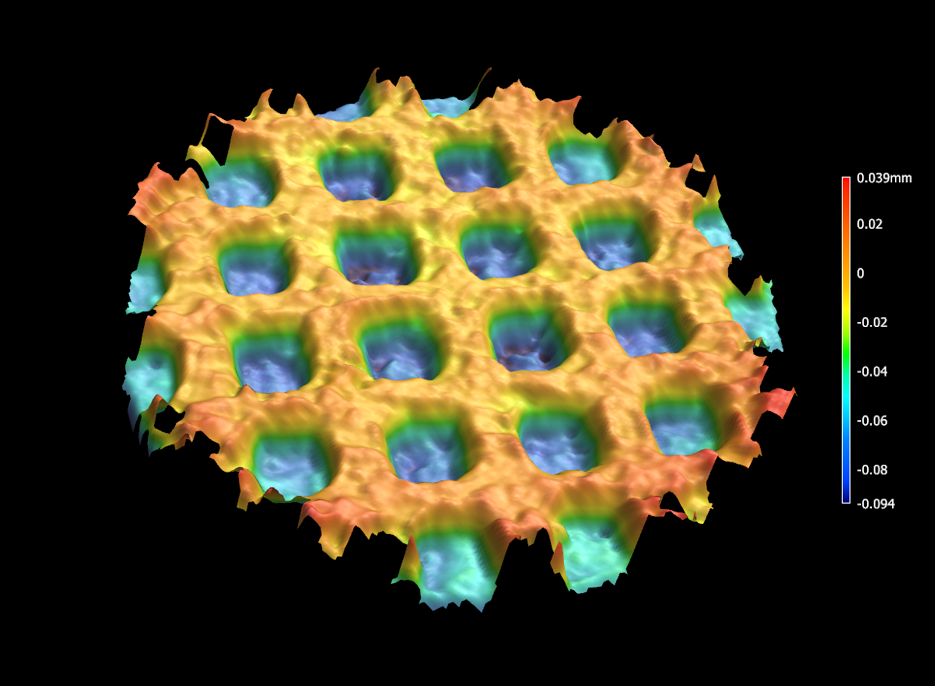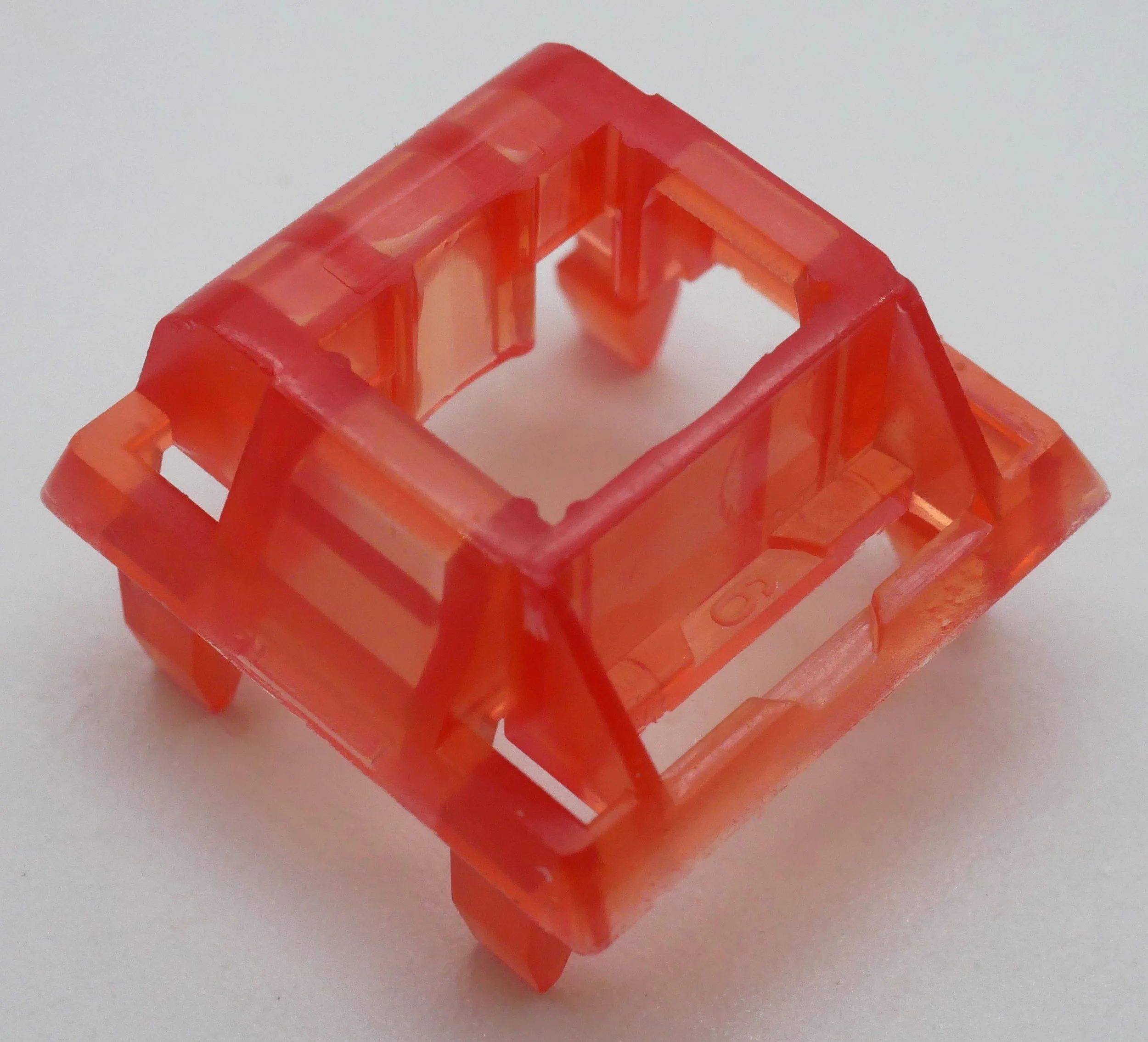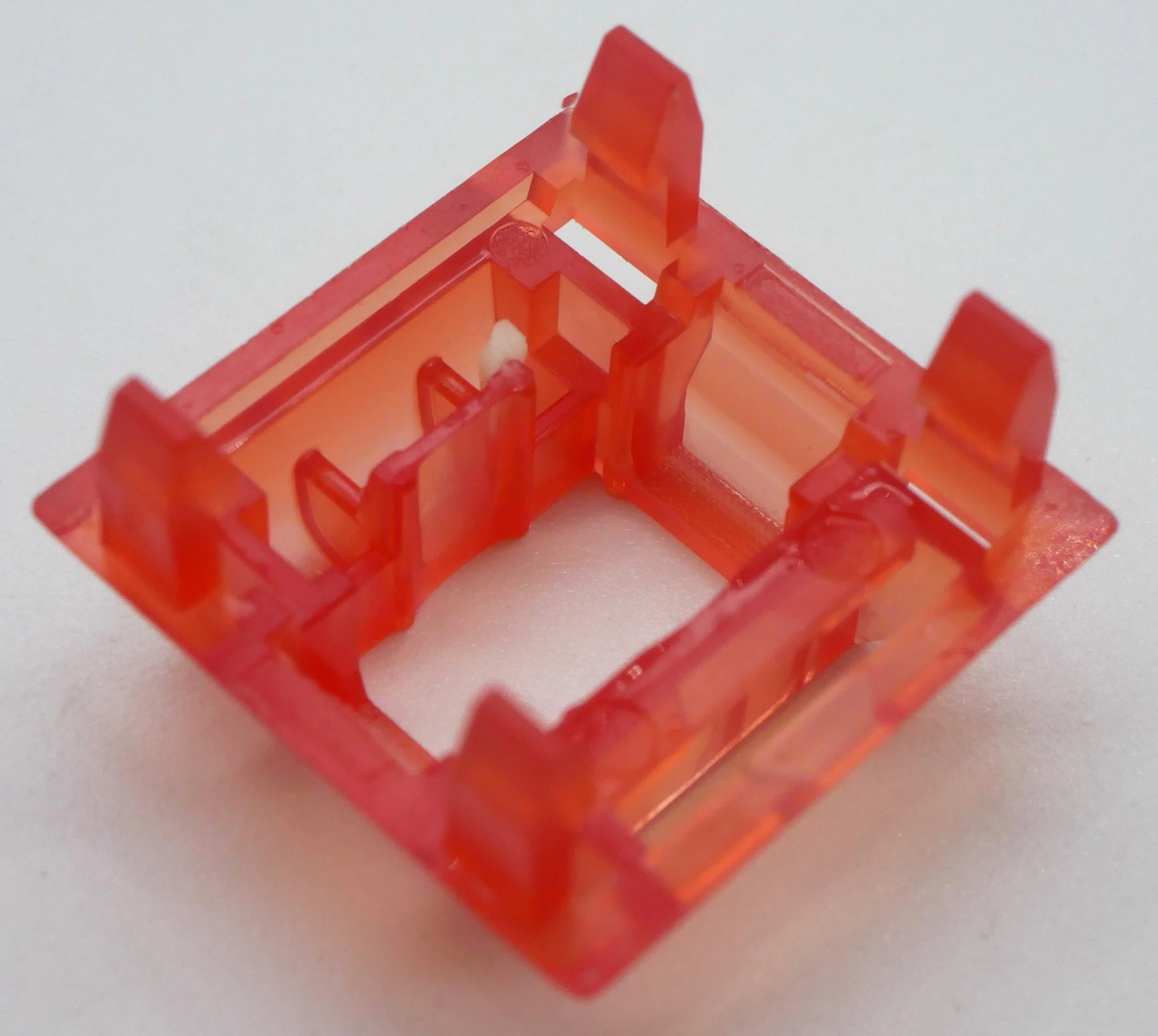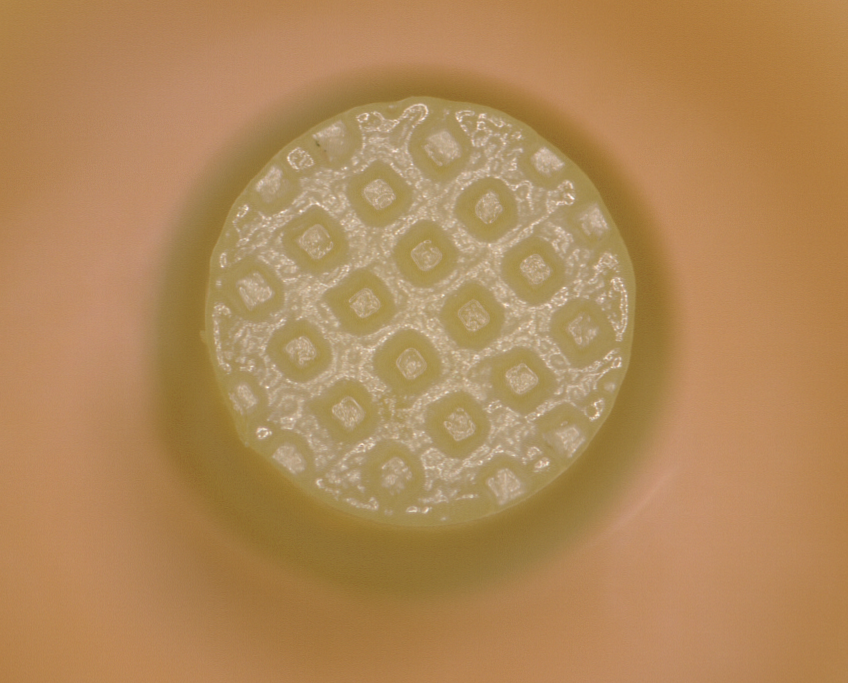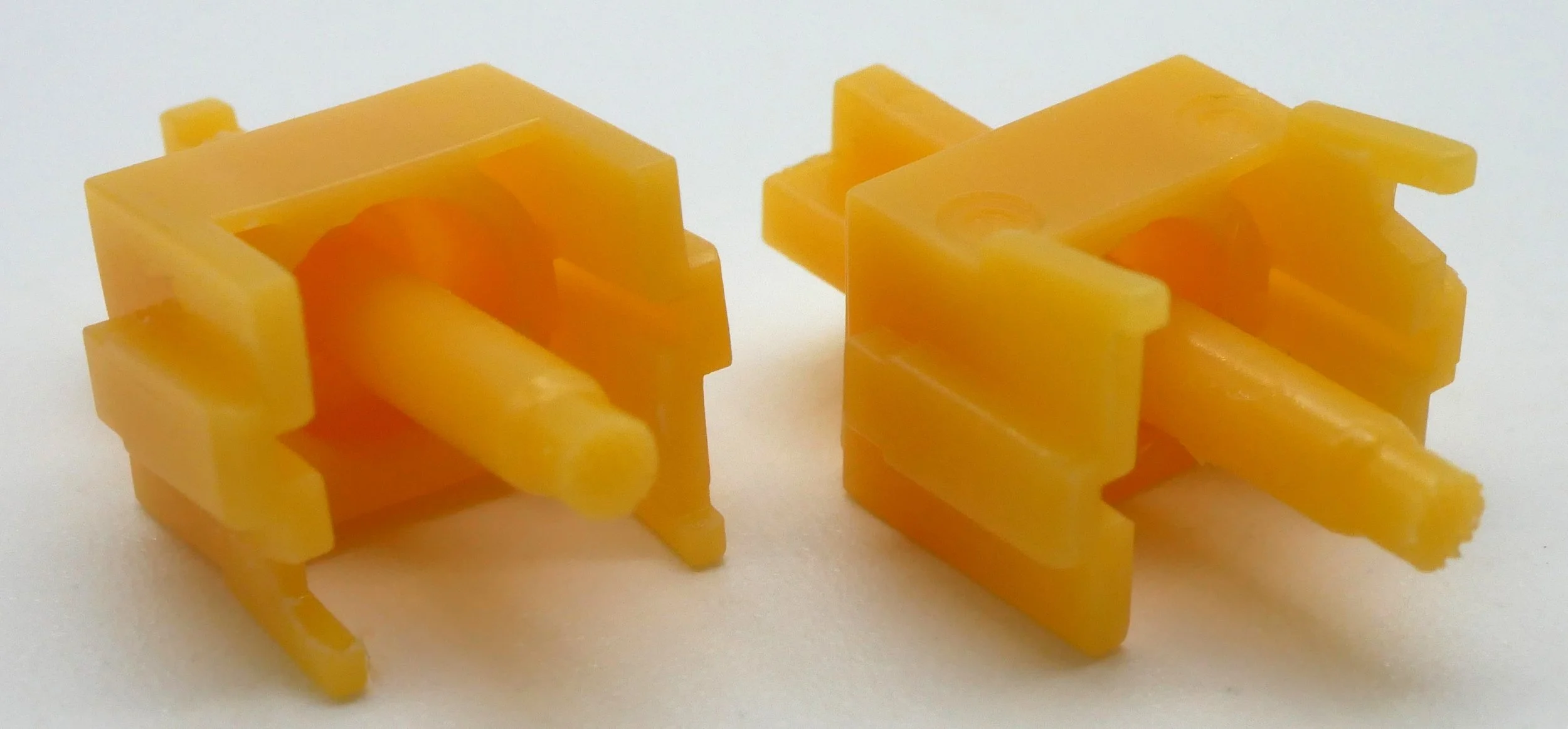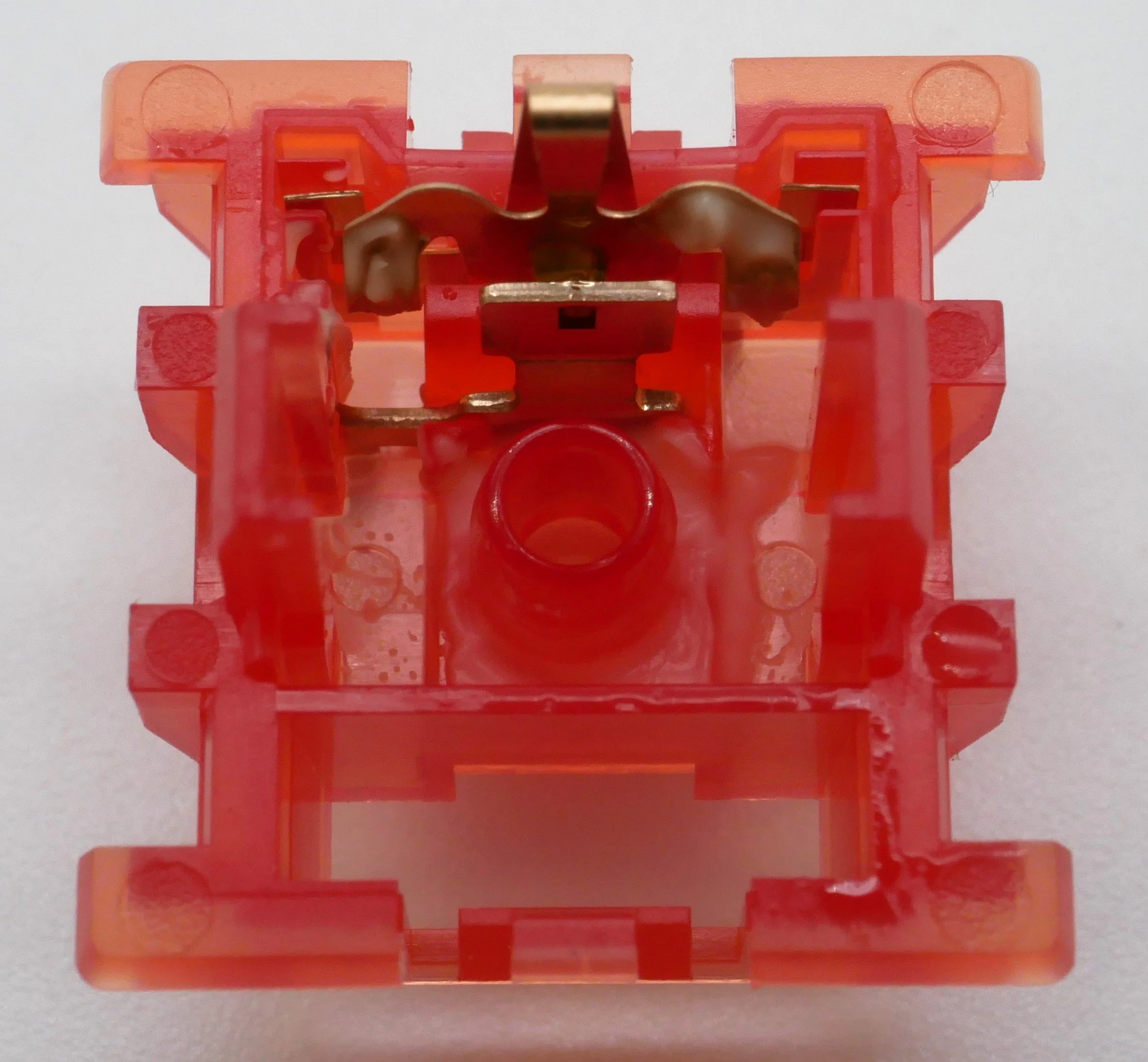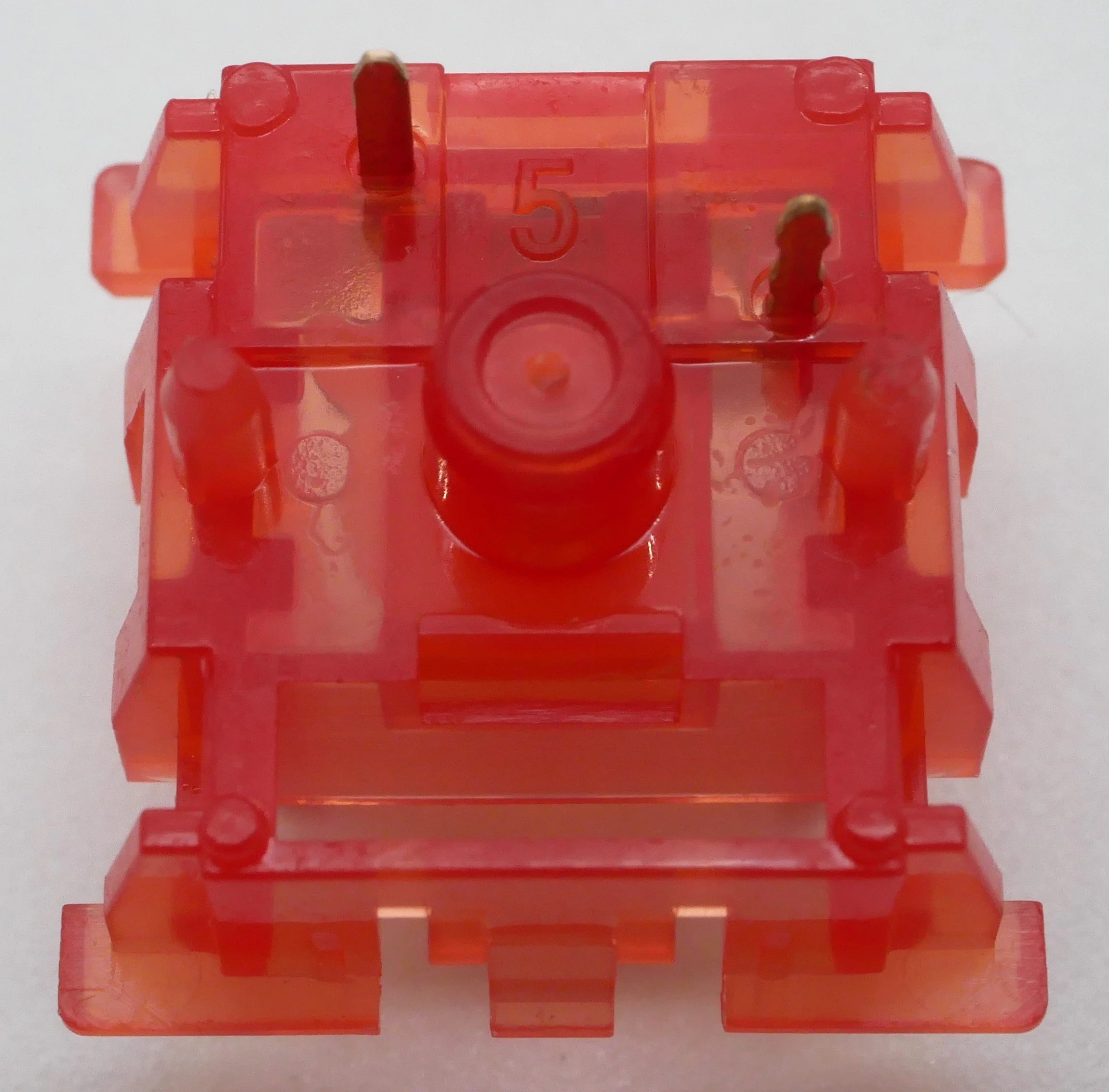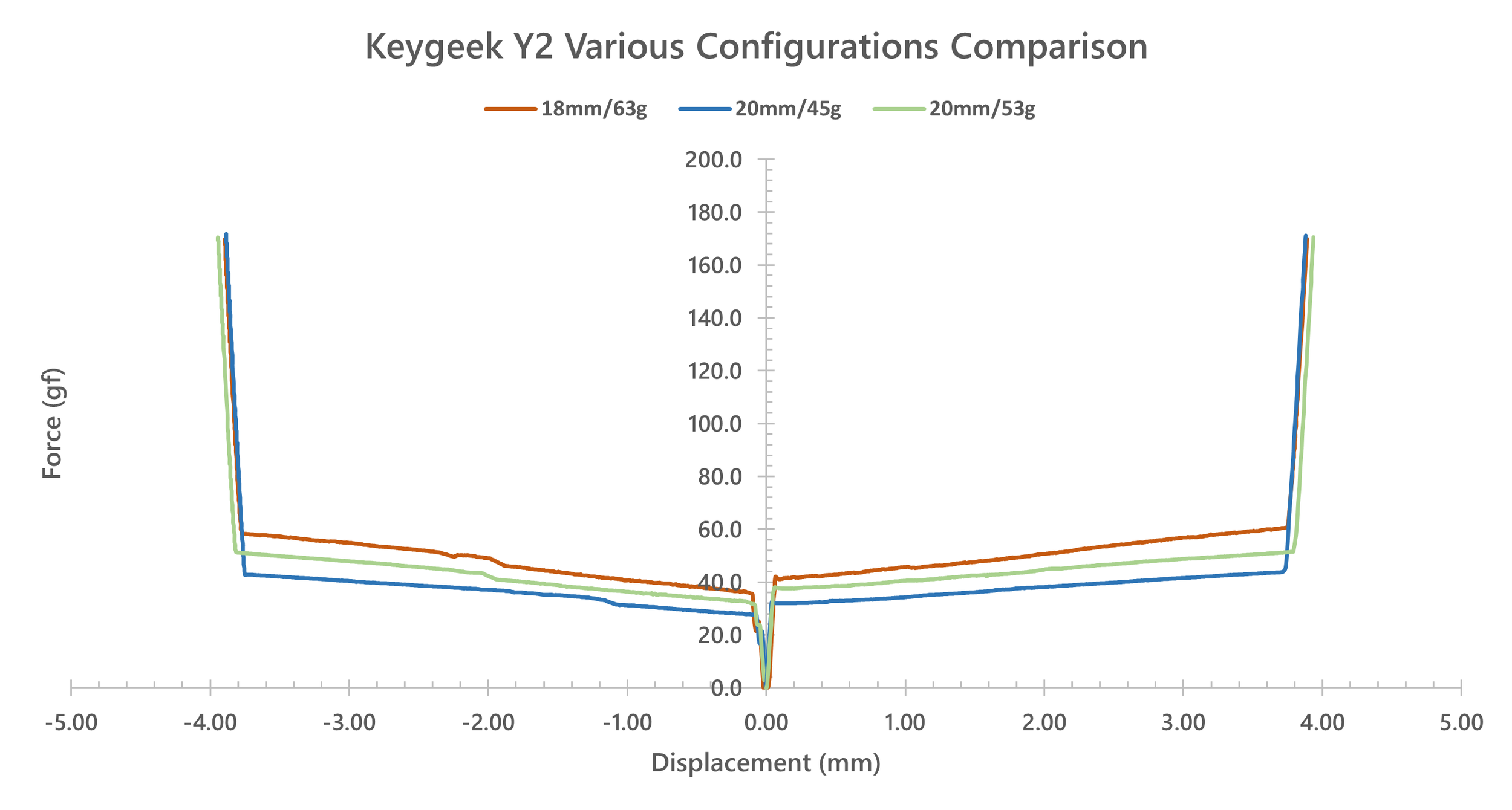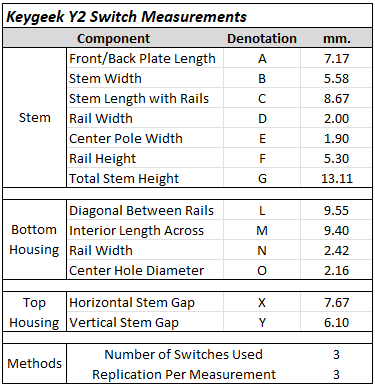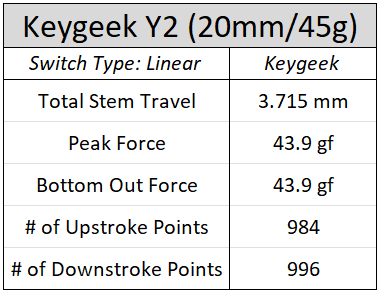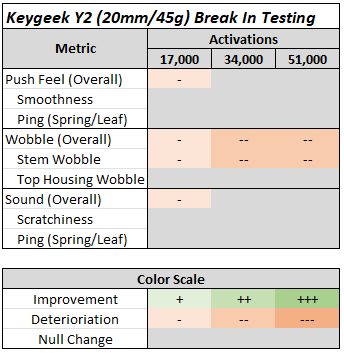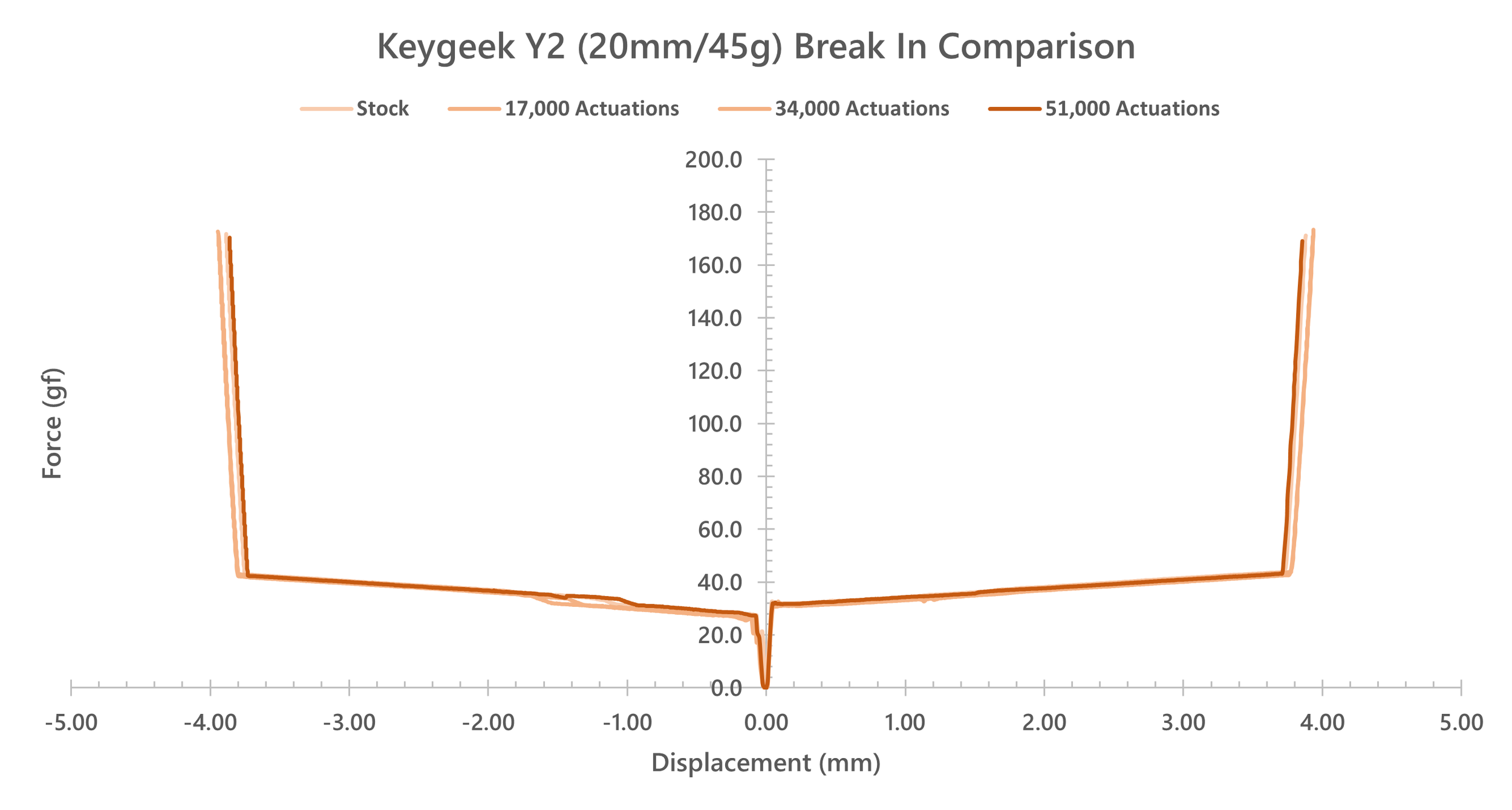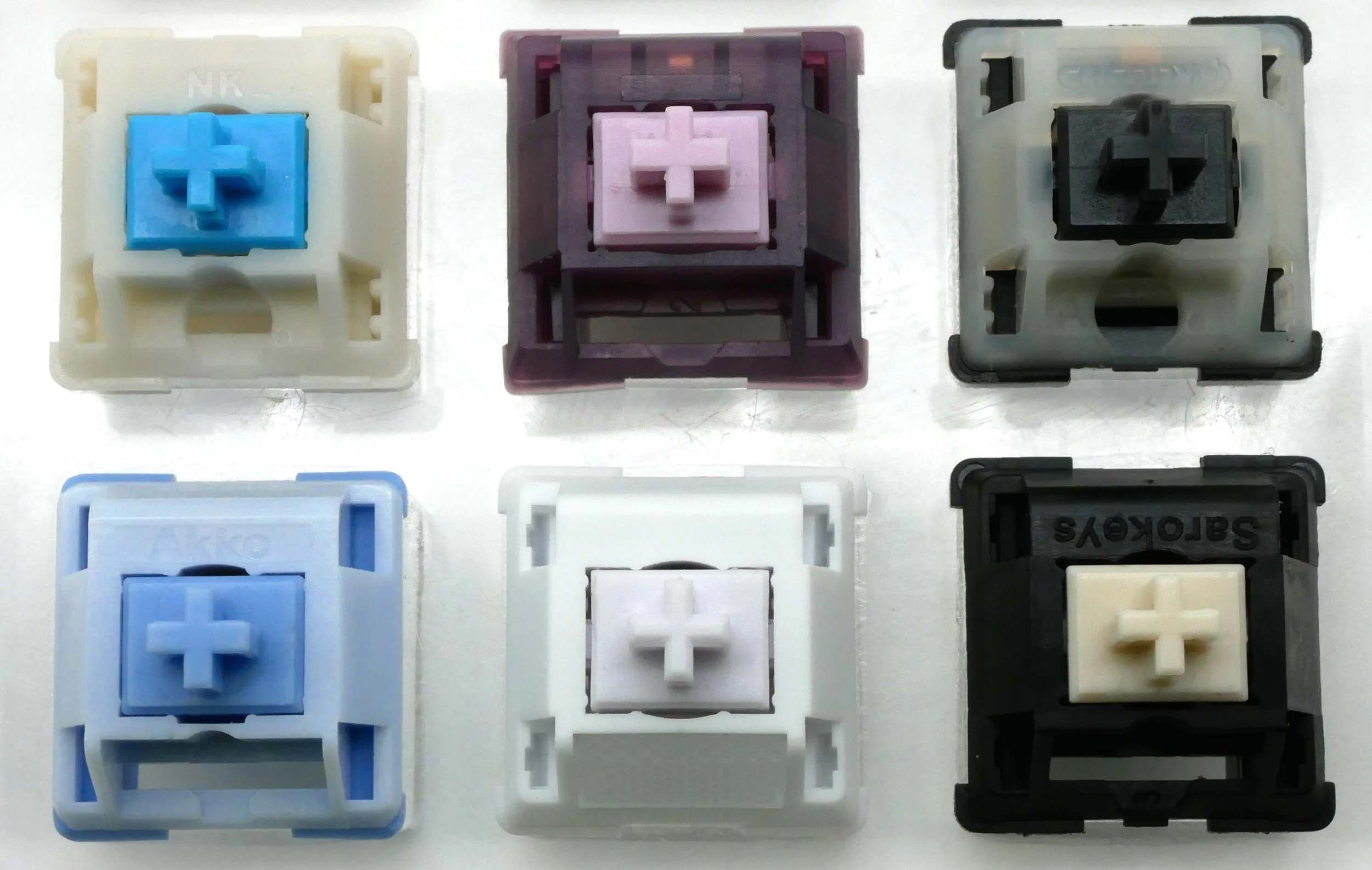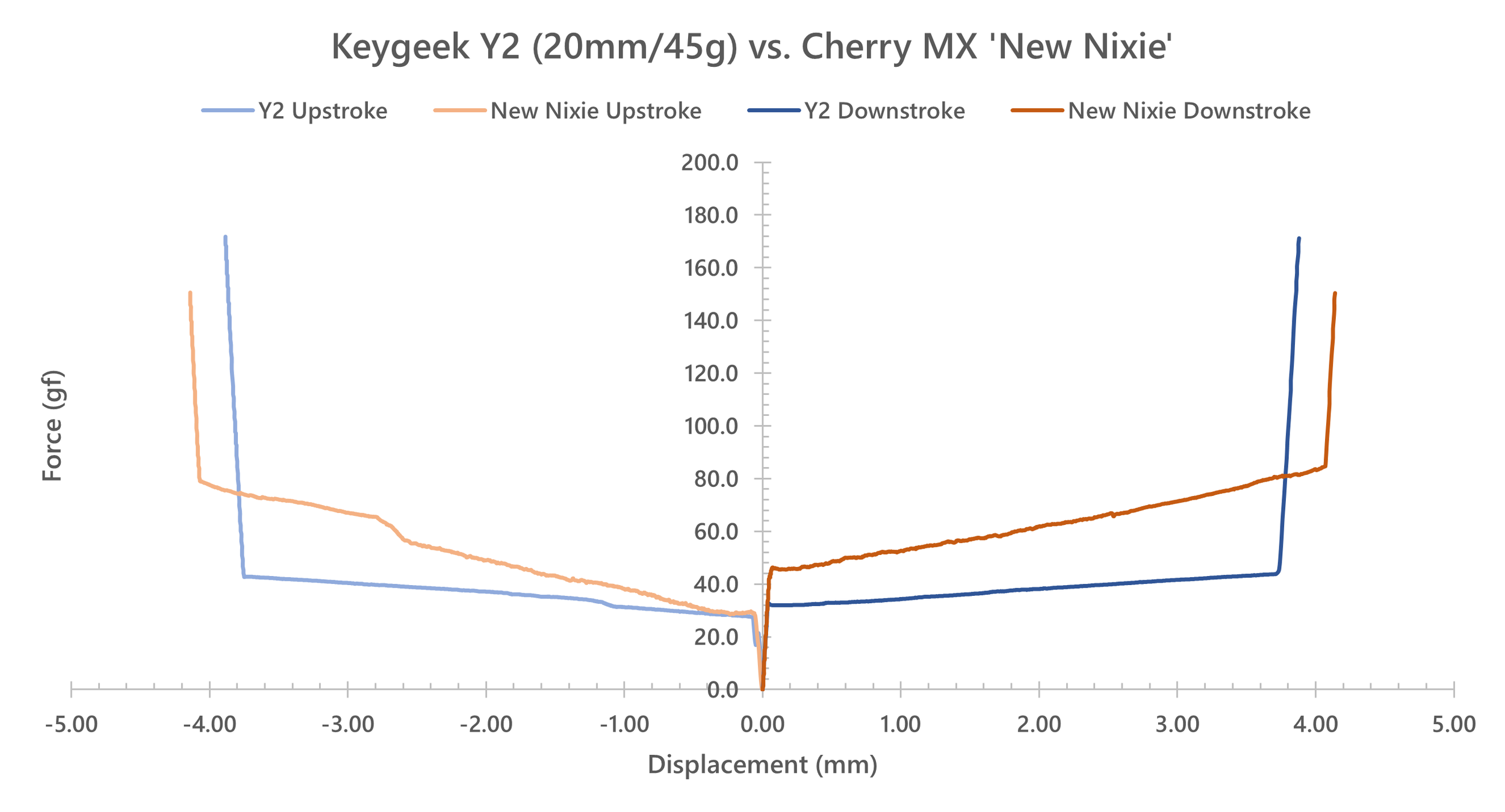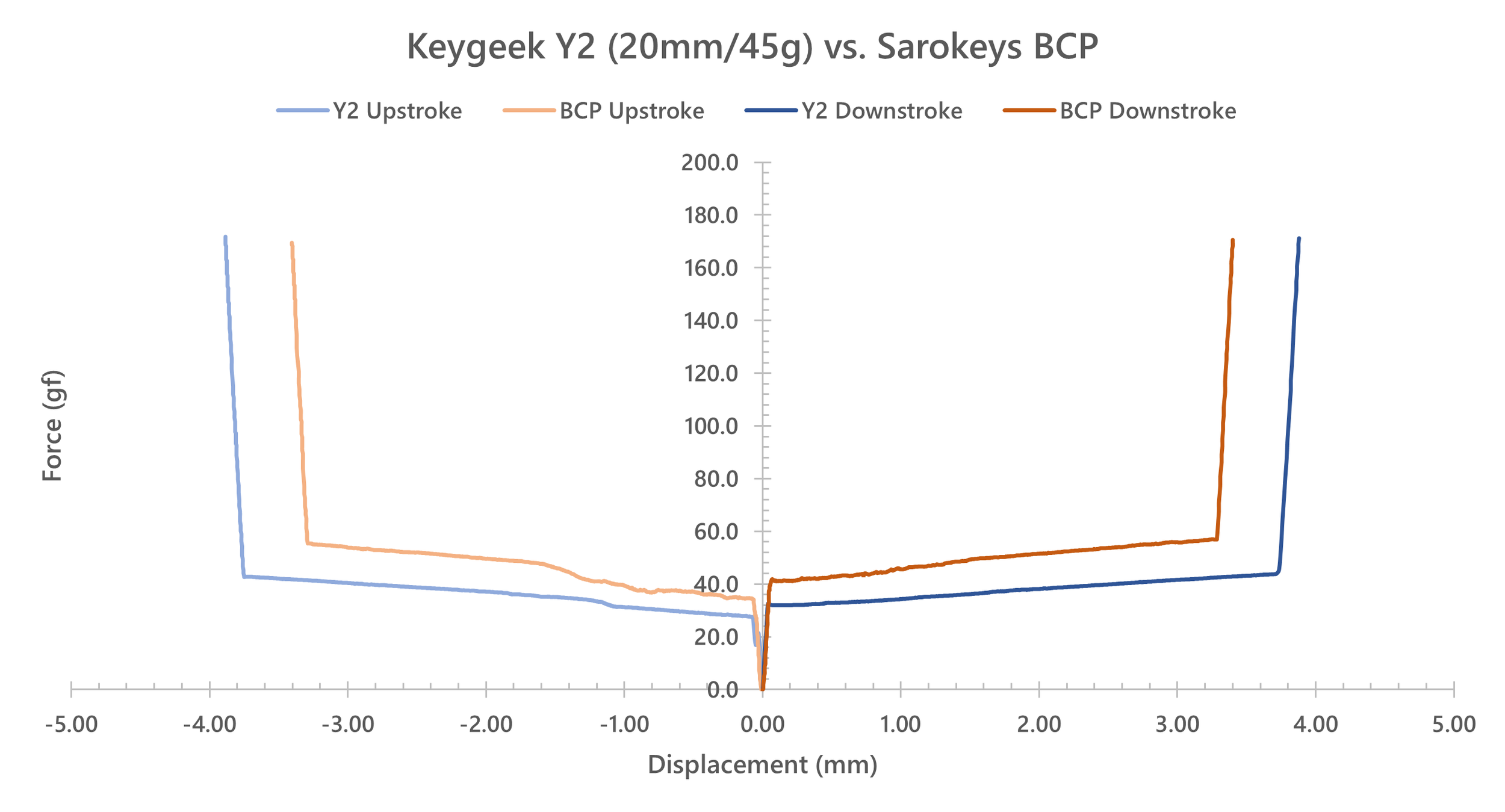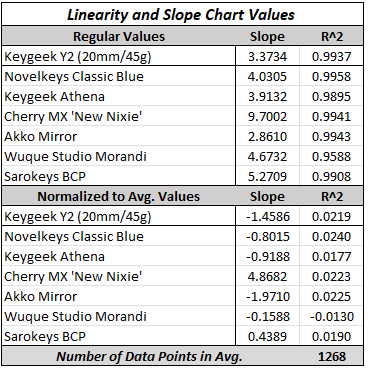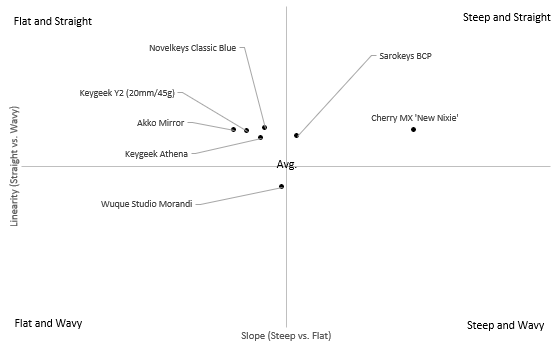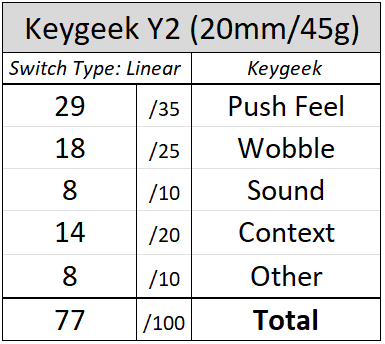Keygeek Y2 Switch Review
Assuming that everything goes well with the tiny bit of physical work and not so tiny bit of paperwork that still needs done here in the coming weeks, this will officially be the last review I’m writing from the current keyboard office. For the past two and a half years or so since I moved back to Ohio, I’ve been sat in the exact same spot in the spare bedroom of my apartment for at least five, if not six or seven days a week working on content, measurements, and reviews for this website. The tables and chairs around me have changed, and the carpet has a large ring shape worn into it that wasn’t there before, but this has been as much of a consistent, constant home as I’ve really ever had in my life. As I’m sitting here going through the motions once more I can’t help but feel a little bit emotional about all of the changes just up the road from me, I must admit. I’ve written the sum total of this website through a dorm room, a couple of different off campus arrangements, my first real solo apartment hundreds of miles away from home, and a little bit of everywhere in between there, though none of those places lasted as long as this one here has. The weekend after this review is first posted I’ll be moving into my first house of my own, so while I’m pretty sure that the record for the longest place I’ve ever written from being here in this apartment won’t persist forever, it doesn’t make this change any less profound in the moment. If artists can get attached to the paint brushes or pens they’ve used over the years, it’d be silly to think that they couldn’t feel similar feelings towards easels, desks, or the walls that they’ve stared through reaching for inspiration over the years. And this blank wall in front of me has been a pretty damn good source of inspiration. Some of my best work has come from behind it. Hopefully not all of my good work.
Figure 1: That first paragraph was narrated in my head by Sisyphus 55 for your own reference.
While I normally try my best to produce content on a regular schedule, or at least that’s what I keep saying out loud over the past couple of months, this is truly and honestly my last planned deviation from my normal schedule for some time. Starting on August 25th and lasting until September 3rd, I’ll unfortunately be a bit busy with packing up, moving, and unpacking everything once again in my new home to be working on content. Thus, I’m going to have to cancel next week’s ‘Scorecard Sunday’. While I do want to apologize for this temporary blackout, as well as for the fact that I very likely will not be getting any force curves into the repository that weekend either, I feel as if this is at least a semi-reasonable decision on my end for the sheer number of keyboards and switches that I have to move, let alone everything else in my current place. I can at least promise that I’ll try and post a social media update or two to remind you all that I am still alive and have not yet been crushed to death by a pile of switches spilling out of a UHaul truck, though you can never be too sure what will happen. After September 3rd, my working plan is to be fully established in the new house, back behind the keyboard once again, and fully cranking through the next review that is scheduled for September 7th. Yes, I recognize that this means I’ll be attempting to have a complete review together and posted within a week of packing up, moving, and unpacking my entire place, though nobody has ever accused me of being sane before so I don’t know why they would start now. Switches and writing about them are such a regular staple of my routine that I’m pretty sure it’s the only way I’ll actually feel like I’m truly “at home” again, even if it is amidst a pile of boxes or general uncertain chaos. But before we get to travel down that very fun path, we do at least have one more review to get through here together. I promise it’s got fun stuff too even if I have been busy with seemingly every other aspect of my life during the preparation of it.
Switch Background
While it’s quite rare that I am able to string together the conceptual backgrounds of two consecutive switch reviews, I think that there are still some thoughts lingering about in my mind regarding the Novelkeys Classic Blue switches and the new “combinatorial manufacturing paradigm” that I introduced in said review. As detailed there, Kevin, the owner and main point of contact for the keyboard brand TypePlus shared with me that their switches were not just made by one single company from start to finish, but rather a series of three consecutive companies working one after another – one which created the molds, one which did the injection molding of the switch parts, and one final one that lubed and assembled the final switch components. Flying completely in the face of the mental model that I and many western keyboard enthusiasts have of a fully vertically integrated switch manufacturer, I spent a good amount of the background of that review just pondering the different things that come out of a new idea as such. What happens for documentarians like myself when we can’t truly pin a source down for where switches are coming from? Does this meant that switches I’ve been purchasing from “Manufacturer A” could actually be being made by “Manufacturer B” instead? Most importantly, I rounded off this pondering suggesting that this may ultimately lead to more nuance and variety among the switches that do get produced out of models like this rather than from just one single manufacturer. However, I never really gave a sort of coherent path as to how I think this sort of nuance and variety could arise organically through such. With each branch of the switch manufacturing process now being separated, these leaner, smaller companies that are occupying their territory simply won’t have the capital and R&D resources to develop revolutionary switch designs from the ground up. It’s just simply improbable, for example, that a mold manufacturer could or would develop the molds for a new modular or multi-typed switch from scratch without any ability in house to test inject and combine parts of their own. As well, these shadowy companies from the background won’t be able to necessarily externally market themselves based on their successes either. Instead, these companies will have to develop subtle special niches that make them stand out from the pack. Small, but not insignificant details like being able to subtly alter multiple different portions of molds at one time, inject and develop new combinations of switch plastics never tried before, or simply more accurately and consistently lube switches for final assembly will be the future of what makes or breaks successful companies. And in turn, what we at the consumer end will get are switches that are a large pile of very subtle, specialized details and not nearly as much of the marketing fluff or big names to bolster their unique performance to relevance. It’s almost editorially serendipitous just how much the Keygeek Y2 switches fit nearly perfectly into that kind of broader shift when you really sit and think about it…
MZ Studio, also sometimes just shortened as “MZ”, is arguably one of the more prolific switch designing entities that exists in the current mechanical keyboard space that I have yet to address really in any capacity. This isn’t entirely coincidental, either. One large thing that has made MZ difficult to talk about is that they simply haven’t been nearly as popular to western keyboard enthusiasts as they have to eastern ones. While most people in the west only started hearing about MZ in late 2023 with their “Z1” switch release, myself included, this was actually the fifth switch that they had designed, had manufactured, and released since mid 2022. Without a broader discussion or awareness on things like the MZ Yellow Arbor, Milk Rider/Mean Bean Knight, Ice Creams, or Industrial Orange switches, it’s really hard to pin them down on the broader switch market radar amidst all of the other ongoing blips elsewhere. The second thing that has made MZ difficult to talk about is since we in the west really became aware of them with their Z1 switch groupbuy they’ve decided to make all of their subsequent releases about as sterile and opaquely similar in naming to one another as possible. Following the Z1s were the Y1s, the Y1Xs, Y3s, U3s, and then most recently the Y2 switch from just a handful of months ago in 2025. No, I want to stress that this wasn’t a string of typos on my end either – these oddly straight forward, not-so-playful names also appear to be in pseudo reverse alphabetical order with additional non-linear numerical modifiers as well for show. The MZ catalogue beyond 2022 hasn’t exactly been something that is conducive to a well written, easily followable paragraph if you ask me. (Not that my general writing style would make that any easier either, for the record.) And despite the inherent confusion MZ introduces with each new gropubuy post, they’re becoming increasingly popular for what they do with each switch release – a subtle, one or two component twist on the classic MX style switch. With the Y1s they did a PBT-based bottom housing and a new, mysterious switch stem material blend. For the Z1s, MZ chose to use a new “LY” material stem and pushed them through molds that just don’t cleanly line up with any existing manufactures as we know them. And with the U3s they released Jerrzi-made silent linears that have very non-standard looking dampening pads. Did I forget to mention that each and every single one of these releases seemingly comes from a different manufacturer? It’s as if the entire modus operandi of MZ Studio’s releases since 2023 have been following exactly the same path I described above – subtle, one off unique adjustments to one or a couple of the parts of switch with the goal of producing something entirely stand out for it’s performance and not any part for it’s marketing or recognizability. As for the ‘Keygeek’ Y2 switches, well these appear to be first of these new style MZ Studio switches to really strike a new and subtle difference that isn’t just a new housing flavor or stem shape – they’re microtextured.
Figure 2: No seriously - this is an 80x magnified image of the topping out portions of the Keygeek Y2 top housings.
Figure 3: Also seriously - every single one of MZ Studios' switch announcements reads like an entry from my lab work at book when I'm trialing new product formulations.
Unlike all of the previous switches which MZ Studio has released over the last couple of years, the Keygeek Y2 switches are the first linears that meet MZ Studio’s apparent goal of producing switches with unique sound profiles by purely mechanical means rather than balances of specific housing materials. Instead of creating a new mystery blend of materials, the molds used in the design of the Y2 switches featured incredibly small ‘microtexturing’ on the very bottom tips of the stem poles and upper portions of the top housings with the goal of modifying the sound of them at bottoming and topping out. While polishing of switch parts and molds, another subtle form of texture manipulation in the final product, is something that has been marketed by several manufacturers over the years as a means of improving the smoothness of switch parts, this is the first time I’ve ever heard of a mold manufacturer intentionally giving something more texture to try and deliver a target result. The result is regular square grid or waffle like pattern on both ends of the switch that is almost so subtle that it could easily be missed even when you’re looking directly at it. Despite all of the R&D that these larger companies muster up and crank out designs with years over years, someone at a mold manufacturer (who I’m suspecting may not actually be Keygeek because of this new paradigm and my paranoia resulting from it) has found a way to do something unique, subtle, and technically quite different from everyone else in the pack. In fact I’m not entirely sure how they managed to do such. Did this mold designer include a special ‘drop in’ part to the bottoms of the stem molds that could give this effect on demand similar to how nameplates work? Does this manufacturer have access to ultrafine engraving tools that simply haven’t been used elsewhere in switches before? Maybe it’s not even a mold manufacturer and instead an injection molder has found a way to post-process the stems and housings though the use of a hot embossing tool. Who really knows? Whoever is doing whatever this is to induce this kind of design on the Y2 switches, be it Keygeek or otherwise, it clearly seems to be having an effect on people as these are by far the most well known MZ Studio switches to date. Whether this signals that my thoughts about how these smaller mold manufacturers or solo injection molders are going to strive for relevancy through these unique capabilities is actually true or not, though, will only be something that we’ll be able to see in time. Something tells me this will be far from the last time we see microtexturing like this pop up in switches…
Figure 4: I don't know how to actually use polymarket so someone needs to set this bet up so I can put money on it. I know I'm like 3 parlays deep in my own thoughts but I swear it'll hit.
Crash landing us back to reality and far from the lofty clouds of speculation, the Keygeek Y2 switches were first announced by MZ Studio for sale back on May 30th of 2025. While some initial teasers for these switches pointed to four different combinations of spring lengths and bottom out weight combinations that would be available for sale, it wasn’t until the groupbuy launch date that these microtextured linears featuring stems made of “U5” material and housings made of “PA12” material would be listed at a sale price of 1.5 RMB or $0.21 per switch regardless of configuration. The initial groupbuy for these switches took place via TaoBao and sold out the maximum 100,000 Y2 switches in total rather quickly, leading to second and third batches of the Y2s being listed for sale on June 29th and July 27th, respectively, with both selling out similarly as quickly. Sometime between the first and second batch of Keygeek Y2 switches being released, they were picked up by Unikeys, Lumekeebs, and likely a few other western facing vendors where they began to be resold around $0.35 per switch – an expected markup versus eastern market pricing for what it’s worth. As of the time of my purchase of Keygeek Y2s in early August of 2025, Unikeys only had three of the four varieties available, though as of the time of writing they now feature all four as described below. Regarding the general long term availability of the Keygeek Y2s from either Unikeys or MZ Studio directly via Taobao, I am completely uncertain as to what will occur. This is not the first time MZ Studio has had a switch which has had multiple release batches, with the Y3s going through ten different batch iterations, though it does appear as if these are the largest and most immediately successful switch releases they’ve had today. Unikeys, at the least, will likely continue to support these until MZ Studio is done running batches.
Figure 5: Keygeek Y2 marketing photo from MZ Studio leading up to the May 30th groupbuy date.
Y2 Performance
Note: There were many different stock variations of the Keygeek Y2 switches available for sale from Unikeys when I picked up this batch for the review. Since I did not want to write multiple confusing reviews in parallel, I have chosen to primarily focus on reviewing the variety listed as ’20 mm / 45g’, referring to their spring length and bottom out weight. Explicit references to the ’20 mm / 53g’ and ’18 mm / 63g’ varieties will be noted when mentioned.
Appearance
At the highest level, the Keygeek Y2 switches come in a very unassuming colorway with translucent red housings and a golden-yellowed colored stem that is about as mundane as their naming convention and the general marketing that surrounds them. Sure, this colorway is at least visually striking compared to a classic OEM-style full black housing look, though in the grand scheme of switches that have been made over the last decade they do blend into the likes of Gateron Vermilion Birds, Jerrzi Fortunes, so on and forth. I’d further expect to see this sort of colorway only reappear more in future Chinese New Year variants of switches as more and more companies celebrate that annually with specialized switches for the occasion. In addition to their colors, there’s really nothing that helps identify the Keygeek Y2s as being unique or differentiable in any way, with maybe the closest thing to an identifiable mark on them being the short, small rectangular “Keygeek nameplate” that they feature on their top housings. None of the three varieties of switches that I received had any differentiation among them either, with only the springs internally being the thing that separated them from one another. However, unlike every single other switch that I have reviewed to date I can say with supreme confidence that these switches do have features and details at the sub-part, and even sometimes sub-visual levels that make them more than worth the extra effort in this section. While I would normally then say something to the effect that these features will be found discussed in the paragraphs and photos below, I do want to warn you that I did break out the “big guns” for this one. Check out what you can do when you put a keyboard switch in a very, very expensive piece of lab equipment specifically designed for reading textures.
Figure 6: You'll unfortunately have to wait another paragraph or so before I go over the waffle texturing on the stems...
Figure 7: Keygeek Y2 switches and their components.
The translucent red, PA12 top housings of the Keygeek Y2 switches are definitely the most deceiving of the parts that comprise this switch and it’s purely for the fact that their most interesting details are somehow even more subtle than that of the texturing on the tips of the stems shown below. Thanks in no small part due to the Keygeek Y2 switch review posted online by Keeb Taro who pointed out this detail that I entirely missed on my first viewing of these switch parts, the very upper portions of the inside of the top housings where the slider rails top are actually microtextured with a similar repeating, waffle-like grid pattern as the stems are. As a result of this grid pattern being smaller, filled sufficiently with lube, and in an incredibly awkward location to try and stick a high strength microscope, I was only unfortunately able to optically image this portion rather than do any rendering or profile analysis on it, though it’s presence is clearly undeniable. Much like the stems, it is believed that this texturing was put there specifically with the design intent to help deaden the topping outs and not make them sound quite so harsh. Beyond this incredibly neat detail, though, the top housings are otherwise fairly mundane and feature a Keygeek style, small rectangular blank nameplate, a wide open LED slot with a centered circular indentation, and a single number mold marking on the exterior of the housing on the inner edge of that indentation.
Figure 8: Keygeek Y2 top housing exterior showing 'Keygeek rectangle' blank nameplate, wide rectangular LED/diode slot, and centered numerical mold marking on interior edge of said slot.
Figure 9: Keygeek Y2 top housing interior showing reinforcements underneath the nameplate region, some mold ejector circles around the LED/diode slot, and very faint texturing at the point of topping out as shown magnified in earlier images.
As for the golden-yellow, U5 stems of the Keygeek Y2 switches, these are where the entirety of the hype, expectations, and really the performance of these switches lie. Well more specifically they lie in the very tip of the stem pole and not in any of the other mundane features of these stems. Speaking of such, these mundane features are the only things that stand out about these stems on initial glance. Barely tapered slider rails, small mold ejector circles, a tiered center pole, barely average stem length of 13.11 mm, and even some light factory lubing on them all paint a very bleak and commonplace picture for their design… until you look closely at the bottom of the stem pole. On the very tips of the stem poles of the Y2s, there is a very fine, repeating square indentation pattern texture that has been given the colloquial name of the “waffle tip” due to its resemblance with the namesake food. Intentionally placed their by the switch designers, this waffle pattern was specifically chosen as it was believed that the reduced surface area of contact for the stem would help effectively deaden the bottom out sound of the switch and thus make it sound ultimately deeper. As can be seen below in the more highly focused images, this waffle pattern is a regular repeating grid of sunken squares that consists of about 24 holes on the base of each stem tip – each approximately 0.2 millimeters in length on one side and 0.1 millimeters in depth. Despite being such a fine texture on an equally small surface, the hole sizes, spacing, and depth are all remarkably uniform both within each stem and across the multiple stems that I did look at under the high powered microscope. While I was not able to process multiple of these stems through the texture rendering that the one stem below was subjected to, I was able to at least visually note that this grid pattern is not oriented in the same way from switch to switch. None of the stems that I saw were directionally oriented, with the squares running a bit off center from any one N/S or E/W axis and with some stems appearing visually to be ~ 20-40 degrees rotated clockwise on some tips and counterclockwise on others. (While it is a regular repeating pattern, the fact that some holes ‘clip’ the edges of the stems do give them a sort of sense of orientation visually.) I don’t necessarily think that this inconsistency in orientation means anything specific, rather that it suggest the process by which this pattern is created could have multiple different ways it could be done. For example if it were an insert into the base of injection molds, the little “texture pucks” they use may not always fall into the slots exactly the same every time.
Figure 10: 80x enhanced optical image of the very tip of a Keygeek Y2 stem pole tip showing the 'waffle tip' microtexture in detail.
Figure 11: Texture rendering of the Keygeek Y2 stem waffle tip showing a profile of what several consecutive holes in the tip look like.
Figure 12: Keygeek Y2 stem front and backsides showing barely tapered slider rails, front plate mold ejector circles, and very subtle traces of the waffle texturing on the tips of the stem poles.
Finally arriving to the translucent red, PA12 bottom housings of the Keygeek Y2 switches, I am saddened to say that these do not feature any cool details that would normally escape the human eye at first glance. (That is of course assuming that there aren’t any details small enough to be missed by the human eye multiple times over!) Internally the housings feature a ‘centered rectangle’ design and have a raised surface along the base that stretches from where the south side spring collar would be all the way around the stem pole hole and ultimately to the base of where the metal leaves insert. The slider rails appear to be effectively barren and without any grooving or padding, as well. The only real feature internally that stands out is the sheer amount of factory lube that is present, with large white pockets able to be seen from quite a distance in the base of this centered rectangle as well as on the majority of surfaces of the switch leaves. Externally, Keygeek Y2s come in PCB mount/5 pin variety and feature a lone, single number mold marking that is in its common place between the metal PCB pins.
Figure 13: Keygeek Y2 bottom housing interior showing a lack of slider rail decoration or dampening and a metric ton of lube dispersed everywhere in, on, and around the housing.
Figure 14: Keygeek Y2 bottom housing interior showing PCB mounting pins and a single number mold marking embossed between the metal PCB pins.
Push Feel
As stated both in the background and appearance sections above, there’s absolutely no doubt in anyone’s mind that the main focus of the design efforts, execution, and in-hand performance of the Keygeek Y2s was centered around their microtextured, ‘waffle’ pattern parts. And while this is a really large gamble to make on such a small set of features, it absolutely pulls its own weight here – the waffle texturing actually seems to noticeably and distinctly elevate the Keygeek Y2 switches beyond that of just what they would be otherwise. Despite being only on a fraction of a square millimeter in total, the waffle patterns on the housings and stems of the Y2s have created linears that have snappy, firm, though not overly harsh housing collisions as well as subtle, almost silent linear-like dampening without any of the hallmark squishiness associated with such. In fact this effect is so strong that upon trying these switches in hand I initially had believed it to be due largely to the choices of housing material or egregious amounts of factory lube present more so than just this texture pattern. Swapping out the stems from the Keygeek Y2s and replacing them with a similarly long, dry stem pole from another switch, I was surprised to find that this testing frankenswitch was noticeably sharper at bottoming out and altogether came across more abrasive at both ends of the stroke. Thoroughly cleaning out the Keygeek Y2 housing and then swapping back in an equally thoroughly dried Y2 stem in an effort to determine if this pattern was somehow trapping and distributing factory lube to yield this effect, I was also surprised to find that this too did not change the bottoming out notes that I had initially encountered. All those efforts yielded were Y2 switches which were just more scratchy throughout their strokes between topping and bottoming out. As best as I can determine, it does actually appear as if microtexturing of stems in the fashion shown in the Keygeek Y2 switches – even to this small of a degree – can and very clearly will make a difference in how the switches perform. It’s honestly a bit astounding if you ask me.
Figure 15: Force curves for stock Keygeek Y2 switches in various spring configurations. (The switches specifically being reviewed here are the 20mm/45g variety in the blue force curve.)
Beyond just the housing collisions, though, the Keygeek Y2 switches are also decently impressive in terms of some of the other key metrics that linear switches are judged on. For one, they’re largely smooth across the batch that I received with only maybe 5 to 10% of the switches in total showing any noticeable variation on such underneath the fingertips – with those that do deviate feeling ‘chalkier’ in their scratch notes than downright scratchy. Despite what you may initially guess from the sheer degree of factory lube that is apparently present in these switches, they don’t at all feel overlubed in stock form and simply just feel like well lubed switches from the factory. As well, the Keygeek Y2 switches have a consistency in weighting and accuracy to their marketing specs which did stand out to me a bit upon testing them at first. While this is certainly far from a metric that gets talked about often both here or in reviews elsewhere, it’s really not all that uncommon to find switches that have a range of weight and spring options available to them that all more or less overlap in their in hand feelings from the sheer lack of tight tolerancing on their parts. For example switches as such could be labeled as “45g” bottom out and yet have weights ranging anywhere from the mid-30g’s all the way up to the mid-50g’s on average. As can be seen in the force curves for the Keygeek Y2 switch varieties that I had at the time of writing this review, though, this simply doesn’t seem to be the case. (Admittedly I did kind of already tacitly expect this of Keygeek and MZ Studio as they’ve both pushed out many, many switches in recent years though it is nice to see them still live up to expectations.)
Sound
The Keygeek Y2 switches do well in continuing to perpetuate the now multi-year long meme on this website of switches having sound profile notes that closely resemble that of their push feeling notes. On the whole, the Keygeek Y2 switches are subtle, snappy, and incredibly mellow on the ears. The references above to their pseudo-silent linaer nature is especially prevalent here in the sound notes as the Keygeek Y2s are noticeably quieter than not only most linear switches in general, but those that also feature longer stem poles that they bottom out onto. At large, this style of linear switch tends to sound louder, harsher, more aggressive, and with housing collisions that are pointed and more in-your-face as a result of their point of contact, though the Y2s simply can’t be described in this fashion. At any sort of normal typing speeds these may as well be closer to silent linears than not, though even at elevated typing speeds they really only increase in volume as a result of their deeper, firming housing collisions becoming more noticeable and not really anything else. What little sound the Keygeek Y2 switches do create at all typing speeds is one that is primarily focused in the bottoming out of the switches and only echoed in the topping outs ever so slightly, sounding deep, firm, short, and snappy in their collisions. On average these switches demonstrate effectively no other errant sounds that would distract from their otherwise lack of sound. No switches in the batch that I received demonstrated ping whatsoever and only a minor amount of them generated shuffling, chalky like scratch sounds that more or less match their inconsistency in the push feeling notes above.
Wobble
The Keygeek Y2 switches have a tiny, manageable amount of N/S and E/W direction stem wobble that is equal in magnitude in both directions and really unlikely to bother most users. While it’s certainly far from wobble-less, these definitely do feel ever so slightly better than average in hand and thus likely will only bother those users that have above average expectations for stem wobble in their switches.
Measurements
If you’re into this level of detail about your switches, you should know that I have a switch measurement sheet that logs all of this data, as well as many other cool features which can be found under the ‘Archive’ tab at the top of this page or by clicking on the card above. Known as the ‘Measurement Sheet’, this sheet typically gets updated weekly and aims to take physical measurements of various switch components to compare mold designs on a brand-by-brand basis as well as provide a rough frankenswitching estimation sheet for combining various stems and top housings.
Figure 17: Numerical details regarding the force curve for the stock Keygeek Y2 (20mm/45g) switches.
Have you ever wanted to be bombarded with more switch data than you’ve ever seen at any point in your life before? Consider checking out the ‘Force Curve Repository’ hosted on my GitHub that contains all force curves that I take both within and outside of these full-length reviews. In addition to having these graphs above, I have various other versions of the graphs, raw data, and my processed data all available for over 1500 different switches for you to use however you see fit. Check it out via the ‘Archive’ tab at the top of this page or by clicking any of the force curve cards above.
Break In
Break In Notes
17,000 Actuations
- At 17,000 actuations, the Keygeek Y2 switches did seem to demonstrate quite a bit of changes with respect to their overall smoothness both in sound and push feel. Rather than moving uniformly across the board one way or another, it appeared as if the good switches got ever so slightly ‘better’ on both of these fronts though the bad switches with scratch issues only seemed to get worse. Surprisingly, though, this seemed to be a phenomenon only related to the switches broken in to this degree as those broken in to later stages appeared more or less on par with the stock Keygeek Y2 batches.
- There was a slight increase in the N/S and E/W direction stem wobble of the Keygeek Y2 switches broken in to 17,000 actuations that wasn’t seen in the stock switches.
34,000 Actuations
- At 34,000 actuations, the noted increase in stem wobble became even more prevalent with the switches broken in to this degree coming across noticeably more wobbly and noticeably less consistent with respect to their wobble than the stock Y2s.
51,000 Actuations
- In spite of the sheer degree of change in the Keygeek Y2 switches that were noted over the first two break in stages, the switches which made their way out to 51,000 actuations appeared to have at least somewhat stopped in their adjustments. I’d imagine a decent portion of the massive amounts of factory lubing present in these switches has managed to sufficiently be shuffled around by this point in time.
Figure 19: Comparative force curve diagram showing no substantial change in the force curves of the Keygeek Y2 (20mm/45g) switches throughout the break in process.
Comparison Notes to Other Notable Linear Switches
Note – These are not aimed at being comprehensive comparisons between all factors of these switches as this would simply be too long for this writeup. These are little notes of interest I generated when comparing these switches to the Keygeek Y2 switches side by side.
Figure 20: Switches for comparison. (L-R, Top-Bot: Novelkeys Classic Blue, Keygeek Athena, Cherry MX 'New Nixie', Akko Mirror, Wuque Studio Morandi, and Sarokeys BCP)
Novelkeys Classic Blue
- In a head to head comparison of their overall push feelings, the Keygeek Y2 switches on the whole come across as the better constructed and more ‘solid’ feeling linear of these two. One reason for this is simply that they’re lubed a fair bit more generously from Keygeek than the Classic Blues were by Typeplus. An additional reason for this feeling is due to the waffle-tipped bottom outs of the Y2s feeling firmer and more substantial than those of the conventional bottom outs of the Classic Blues.
- There’s quite a bit less stem wobble in both directions of the Novelkeys Classic Blue switches than there is in the Keygeek Y2 switches.
- On the whole, both of these switches are on the quieter side when it comes to linears, though the Y2s are noticeably the quieter of the two. Whereas the Classic Blues have medium pitched flat sounding housing collisions, the Y2s are deeper, more subtle, and ultimately more bass focused than the Classic Blues.
Keygeek Athena
- The Keygeek Athena switches have a noticeable bit less stem wobble than the Keygeek Y2 switches in both the N/S and E/W directions.
- In terms of their overall sound profile, both are very deep and richly nuanced sounding linear switches though the Athenas are perhaps the only ones on this list that are all of these things to a degree more than that of the Y2s. Without too much certainty on my end, I suspect this difference is largely due to the combination of a heavier spring weight and full nylon housings in the Athenas than the lighter PA12 bottom housings of the Y2s that have a marginally more airy sounding bottom out to them.
- While you wouldn’t believe it from what the comparative force curve between these two switches below would suggest, the Athenas do feel as if they travel a fair bit further into their downstrokes than that of the Keygeek Y2 switches. Given that there’s clearly not a mechanical reason for this to be the case, I suspect this feeling is being amplified by the fact that the Y2s bottom out onto their stem poles whereas the Athenas do not.
Cherry MX ‘New Nixie’
- As likely a good number of you may have been able to anticipate, the Cherry MX ‘New Nixie’ switches are scratchier and less consistent in their stroke feeling than that of the well lubed Keygeek Y2 switches.
- While these two switches have comparable E/W direction stem wobble, the New Nixies have a decent bit less N/S direction stem wobble than the average Keygeek Y2 switch.
- As a result of their thinner top housings and lack of generous factory lubing, the New Nixie switches simply sound thinner, more plasticky, and slightly less premium than that of the Keygeek Y2 switches. That being said, though, the bottoming outs of these two switches are fairly similar to one another with the waffle tipped stems of the Y2s bottoming out on Keygeek’s PA12 bottom housings producing a firm and slightly muted feeling that is not all that dissimilar from bottoming out onto Cherry’s nylon housings.
Akko Mirror
- Despite both of these switches featuring a stem pole bottom out front and center in their marketing, they are the most disparate pairing of switches on this list when it comes to the sound they make at bottom out. By comparison to the Y2 switches, the Mirrors are brighter, sharper, and a fair bit higher pitched which strike the ears a whole lot more noticeably than the deeper, darker, and slightly dampened sounding bottom outs of the Y2s.
- There is a very, very small amount of stem wobble in both directions of the Akko Mirror switches and there’s not a shot that the Keygeek Y2 switches could come close to competing with them on this metric.
- While these two switches both bottom out at more or less the same spring weighting as can be clearly seen in the comparison curve below, the bottom outs of the Akko Mirrors just feel heavier and more forceful than that of the Y2 switches.
Wuque Studio Morandi
- While these two switches are quite similar to each other in terms of the volume of their bottom outs, the Morandi switches have an extra layer of depth and complexity to them that the Keygeek Y2s simply are lacking. Like a good few other comparisons drawn on this list, I suspect this difference largely comes down to differences in housing materials between the two switches.
- There is ever so slightly less N/S and E/W direction stem wobble in the Wuque Studio Morandi switches than there is in the Keygeek Y2 switches.
- For once, the comparative force curves between these two switches below actually feels somewhat accurate. Even though the Morandi switches feel substantial and singular on their own, when compared next to the lighter spring weight and longer stroke length of the Keygeek Y2s they feel much more compacted and ‘short’ in their stroke feeling.
Sarokeys BCP
- There is a similar degree of stem wobble between the Sarokeys BCP and Keygeek Y2 switches, though on the whole the average Y2 switch does feel as if it is just ever so slightly less wobbly in both directions.
- The Keygeek Y2 switches are not only the smoother of this pair of switches, btu they are also the ones that have housing collisions which feel less aggressive, more subtle, and not nearly as antagonistic at faster typing speeds.
- These two switches exist on fairly opposite ends of the linear sound spectrum from one another, with the BCP switches having thinner, higher pitched, and sharper sounding bottom outs that drive their sound profile whereas the Keygeek Y2s are more quiet, subtle, and soft sounding at their bottom outs.
Linearity
Figure 27: Absolute and relative Linearity and Slope values for each switch in this comparison section.
Figure 28: Qualitative comparison of the normalized Slope and Linearity for each switch in this comparison section.
If you are just now seeing this section for the first time and are a bit confused as to what I am talking about when discussing ‘Slope’ and ‘Linearity’, I highly suggest checking out my article titled ‘On Differences in Linear Switches’ where I explain what this section is for and how it came to be! For a bit of a shorter answer, know that this is part of my ongoing attempt to better quantify and articulate differences between linear switches which have historically not been captured in discussions about them.
Scores and Statistics
Note – These scores are not necessarily completely indicative of the nuanced review above. If you’ve skipped straight to this section, I can only recommend that you at least glance at the other sections above in order to get a stronger idea of my opinion about these switches.
Push Feel
This variant of the Keygeek Y2 switches is a lightweight linear switch boasting PA12 housings, a “U5” material stem, and subtle points of ‘waffle’ microtexturing on both parts that deliver surprisingly deep, firm feeling housing collisions that border on silent linear-like at times in all of the right ways. Mixed with a heavy dose of factory lubing, the Y2 switches come out of the box as muted, compact, and more substantial feeling than the sum of their parts, with only about 5-10% of any given batch suffering slightly from shuffling due to inconsistent lube application.
Wobble
There is a noticeable but not likely too problematic amount of equal magnitude N/S and E/W direction stem wobble in the Keygeek Y2 switches that won’t bother really anyone except those particularly picky about this metric.
Sound
As a result of the aggressive factory lubing of these switches as well as their decreased surface area for housing collisions due to the microtexturing on multiple parts, the Y2s are rather quiet sounding linears with a deep, rounded bottom out and similarly echoing top out that are the main drivers of their sound profile. At faster actuation speeds this remains pretty steady as well, with really only the volume (and not the tone) of the bottom out increasing in turn.
Context
Priced ~$0.35 per switch in the west, the Y2 switches are among MZ Studios’ most successful switches to date and they’ve enjoyed a wide western market appreciation through the main reseller in Unikeys. While accessible, well priced, and with interesting underlying technology, their lack of raw standout ability in a vacuum makes their longevity a tad bit questionable.
Other
All credit MZ Studio for the development of the ‘waffle’ microtexture pattern that very clearly and distinctly alters switch performance and likely will influence many designs moving forward.
Statistics
If you are looking at this statistics section and wondering what the heck ‘Timeless’ and ‘Time Weighted’ scoring is, consider checking out my short article titled ‘A Scorecard Time Change’. As a result of scoring becoming a bit anachronistic over the years, switches are now ranked in this statistics table using a “time weighted total” as opposed to their day-of scoring as discussed in that article. If you’d also like to learn about what ‘hard’ versus ‘soft’ ranks refer to specifically, I’d encourage you to head on over to my GitHub linked in the table above or at the links in the top right hand of this website to check out my database of scorecards as well as the ‘Composite Score Sheet’ which has a full listing of the rankings for each and every switch I’ve ranked thus far.
Final Conclusions
At the tail end of this review, I have to admit that I am far more impressed with the performance of the Keygeek Y2 switches than I was initially anticipating I would be. While I generally try to avoid reviews and/or content about switches if I am reviewing them in an attempt to remain as unbiased as possible, I simply couldn’t avoid the sheer volume of discussion surrounding these particular linears. In each and every video that I both incidentally and then intentionally came across discussing the Y2 switches, the praise for the effect that the waffle stem tips and general microtexturing brought about to the feeling of the switches was not just good – it was overwhelmingly positive. So positive, in fact, that I had to admit I was a bit skeptical. There’s no way that such a small surface area on a top housing and a stem could cause such a noticeable, tangible effect on the performance of a switch. And yet, based on my very own testing as described above, it very much appears that these sentiments were widely true – the microtextured “waffle” pattern on the stems and the top housings of the Keygeek Y2s does noticeably alter their in hand feeling and sound. Rather than the Y2s just being sort of commonplace, standard stem pole bottom out linears that have an overly aggressive sharpness and harshness to their bottom out, the texturing induces a feeling at the housing collisions that make them come across more subtle, more firm, and a lot more substantial feeling than just the sum of their parts. Bolstered by a generous amount of factory lubing that allows for distinct focus on just the housing collisions at either end of the switch, the texturing almost gives a sort of quasi silencing pad effect to the Y2s, making them both feel and sound closer to smooth silent linear switches than not while simultaneously dodging all of the less savory aspects of silent linear switches. All of this simply accomplished through the use of very subtle mold designs and a very strategic placement of a little bit of texture. The concept is not only genuinely impressive, but exceedingly well executed by MZ Studio and Keygeek. And yet, I just want a bit more…
Just a tiny bit more.
While the Keygeek Y2s showcase a concept that could radically impact how MX style switches are designed at the mold level moving forward and then demonstrate that it can and very well will shift how a switch sounds and feels, they use this newfound power to make a random combination of proprietary material blends from Keygeek come across a bit deeper and more like a silent linear than they would otherwise. It’s the most sedated use of an exciting new switch design technology as I think I’ve ever come across before. I mean don’t get me wrong, they’re good switches, very good even, but they have the raw potential to be so much more than what they are. Maybe I’m a bit spoiled as of late I suppose? I just can’t help but type on the Keygeek Y2 switches and wonder what if – what if they would have chosen a different more aggressive texture, or what if they would have put this on the slider rails and sides of the stems as well, or what if…? We now know that microtexturing is an effective way to drastically and noticeably change the push feeling and sound of switches at the mold level and without needing to radically redesign the MX footprint at all… and we’re just going to have to wait for some future switch to come out and demonstrate the full potential of that idea to us. The Keygeek Y2s will unfortunately have to suffice to keep us happy for now.
Sponsors/Affiliates
Mechbox UK
- A wonderful UK based operation which sells singles to switches that I’ve used above in my comparisons for collectors and the curious alike. Matt has gone out of his way to help me build out big parts of my collection, and buying something using this link supports him as well as my content!
KeebCats UK
- A switch peripheral company based out of the UK which sells everything switch adjacent you could ask for, they’ve been a huge help recently with my film and lube supply for personal builds, and they want to extend that help to you too. Use code ‘GOAT’ for 10% off your order when you check them out!
proto[Typist] Keyboards
- An all-things keyboard vendor based out of the UK, proto[Typist] is a regular stocker of everything from switches to the latest keyboard and keycap groupbuys. While I’ve bought things from the many times in the past, they also are a sponsor of my work and allow me to get some of the great switches I write about!
Divinikey
- Not only do they stock just about everything related to keyboards and switches, but they’re super friendly and ship out pretty quick too. Divinikey has been a huge help to me and my builds over the last year or two of doing reviews and they’ll definitely hook you up. Use code ‘GOAT’ for 5% off your order when you check them out!
ZealPC
- Do they really need any introduction? Zeal and crew kicked off the custom switch scene many years ago with their iconic Zealios switches and the story of switches today couldn’t be told without them. Use code ‘GOAT’ (or click the link above) for 5% off your order when you check them out!
MechMods UK
- A rising vendor based in the UK, Ryan and crew have been a pleasure to work with and have nearly everything you’d need to build your first or fourteenth keyboard. Go build your latest or greatest one right now with them by using code ‘GOAT’ at checkout for a 5% discount!
Dangkeebs
- A longtime supporter of the website and the collection, Dangkeebs has quite possibly the widest variety of switches of any vendor out there. Not only is their switch selection large, but it rotates and is constantly adding new stuff too. You’re going to need 5% off your order with my affiliate to save off the cost of all those switches!
SwitchOddities
- The brainchild of one my most adventurous proxies, SwitchOddities is a place where you can try out all the fancy, strange, and eastern-exclusive switches that I flex on my maildays with. Follow my affiliate code and use code ‘GOAT’ at checkout to save 5% on some of the most interesting switches you’ll ever try!
Cannonkeys
- Does anybody not know of Cannonkeys at this point? One of the largest vendors in North America with keyboards, switches, keycaps, and literally everything you could ever want for a keyboard always in stock and with an incredibly dedicated and loving crew. Follow my affiliate link above in their name to support both them and I when you buy yourself some switches!
Kinetic Labs
- One of the most well-rounded keyboard vendors out there, Christian and crew have been supporters of all my switch and switch-adjacent needs for some years now. I’m honored to have them as an affiliate and think you should check them out using my affiliate link above to support both them and I when you check out their awesome products!
Keebhut
- Want to try out some switch brands that fly under most vendor’s radars? Keebhut is always seeking out that next latest and greatest and has been super helpful in hooking me up with new brands over the past year. They are all about sharing that love as well, and want to give you 5% off your next order with them when you use code ‘GOAT’ at checkout!
Kailh
- No, you’re not mistaken – this is actually that Kailh that manufactures switches. As one of the longest running manufacturers in the hobby, they have a massive variety of switches available over on their website at any point in time. I’m lucky to be affiliated with them now, and so consider using my affiliate link above when ordering some Kailh switches to support me!
Keebz N Cables
- Australia and Oceania’s very own is now a part of the sponsor list here and I couldn’t be happier to add this long time supporter of the collection to it. They’ve always got an amazing selection of switches (and other keyboard parts) in stock and they want to share the love that they’ve shown me with you all too! Use code ‘thegoat’ for 5% off your first order when you visit!
Further Reading
Unikeys’ Keygeek Y2 Switch Sales Page
LumeKeebs’ Keygeek Y2 Switch Sales Page
Ktech’s Keygeek Y2 Switch Sales Page
Milktooth’s Keygeek Y2 Switch Sales Page
MZ Studios’ Y2 Switch ZFrontier Teaser Post
MZ Studios’ Y2 Switch ZFrontier Sales Post
UnikeysOfficial’s Keygeek Y2 Switch Review Video


